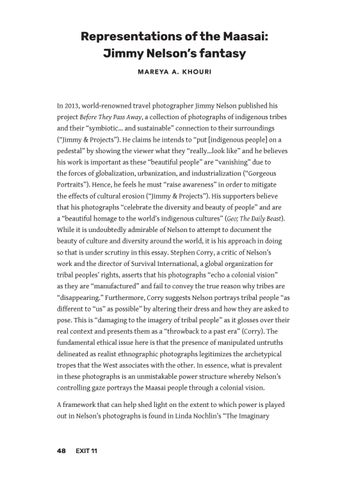Representations of the Maasai: Jimmy Nelson’s fantasy M A R E YA A . KHOU R I
In 2013, world-renowned travel photographer Jimmy Nelson published his project Before They Pass Away, a collection of photographs of indigenous tribes and their “symbiotic… and sustainable” connection to their surroundings (“Jimmy & Projects”). He claims he intends to “put [indigenous people] on a pedestal” by showing the viewer what they “really…look like” and he believes his work is important as these “beautiful people” are “vanishing” due to the forces of globalization, urbanization, and industrialization (“Gorgeous Portraits”). Hence, he feels he must “raise awareness” in order to mitigate the effects of cultural erosion (“Jimmy & Projects”). His supporters believe that his photographs “celebrate the diversity and beauty of people” and are a “beautiful homage to the world’s indigenous cultures” (Geo; The Daily Beast). While it is undoubtedly admirable of Nelson to attempt to document the beauty of culture and diversity around the world, it is his approach in doing so that is under scrutiny in this essay. Stephen Corry, a critic of Nelson’s work and the director of Survival International, a global organization for tribal peoples’ rights, asserts that his photographs “echo a colonial vision” as they are “manufactured” and fail to convey the true reason why tribes are “disappearing.” Furthermore, Corry suggests Nelson portrays tribal people “as different to “us” as possible” by altering their dress and how they are asked to pose. This is “damaging to the imagery of tribal people” as it glosses over their real context and presents them as a “throwback to a past era” (Corry). The fundamental ethical issue here is that the presence of manipulated untruths delineated as realist ethnographic photographs legitimizes the archetypical tropes that the West associates with the other. In essence, what is prevalent in these photographs is an unmistakable power structure whereby Nelson’s controlling gaze portrays the Maasai people through a colonial vision. A framework that can help shed light on the extent to which power is played out in Nelson’s photographs is found in Linda Nochlin’s “The Imaginary
48
EXIT 11
